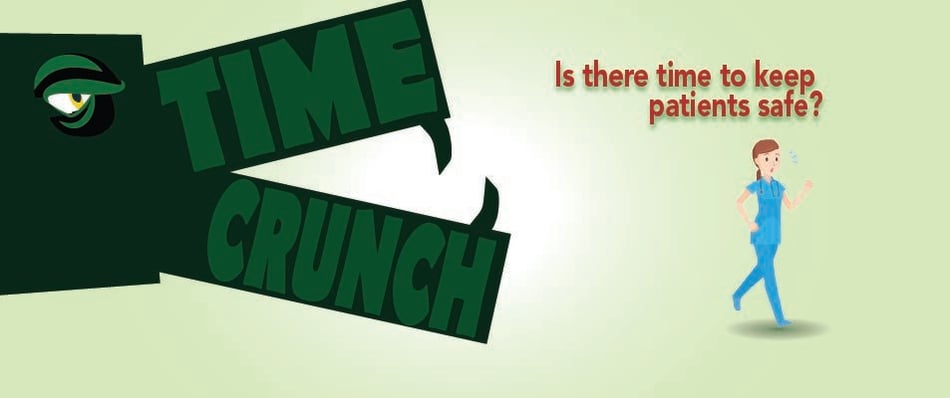Time Crunch: Is There Time to Keep Patients Safe from Infection?

Nursing responsibilities have changed dramatically over the past decades. While some non-medical tasks have been shifted to other workers, additional administrative responsibilities have been added. As a result, nursing is among the top most stressful jobs in our country, made all the more challenging during the pandemic. What happens when nurses feel pressured by time constraints? What can be done to alleviate this pressure? We will look at options in today's post.
A good way to learn about what nurses handle on an average day is to conduct a time study. Researchers observe a cohort of nurses over a long period of time, noting tasks and time usage over hundreds of shifts. The findings are categorized and reveal much about a nurse's responsibilities. Looking back at time studies from the 1960s, for example, hospital nurses spent almost half of their time on what was considered "basic" nursing, that is, the care of patients that did not require medical training (cleaning, labeling, stocking supplies). Only 22% of their time was spent doing "technical" nursing including inserting IVs, taking blood, assessing vital signs, etc. In contrast, contemporary time studies show nurses spending 35.3% of their time on documentation, 17.2% on dispending medications, 20.6% on care coordination (working with other HCWs), and 19.3% on direct patient care. Another study revealed that the least time was spent on optimizing quality and safety of care. A lot more is expected of nurses today, making the career more intellectually fulfilling, but also more cognitively exhausting.
What happens when nurses feel pressured by time constraints? As we all can understand, stressful environments impair decision-making. Nurses themselves state that they have "too much to do without enough help". Information overload also leads to reduced ability to assess patient needs and risks, which can, in turn, lead to misrepresenting one's adherence to protocols to a supervisor in an effort to protect their professional reputation. When time is limited, there is increased risk of errors of commission - making a mistake that impacts patient outcomes. In fact, for every additional hour of direct care by a nurse, there is a 3% reduction in death hazard to the patient.
Alongside patient outcomes, patient experiences are harmed by extreme time constraints; patients are aware that their nurses are rushing and feeling pressured, and they end up either feeling like a burden and not asking for help or feeling their medical care is not being taken seriously.
In studies that simulate hospital care, nurses who were facing time constraints were found to ask fewer questions of the patient, conduct less thorough examinations, and provide less guidance and education to the patient. While these shortcuts may not lead to medical errors each time, they allow for the possibility of errors of omission, that is, missing an important symptom or piece of information that delays appropriate treatment of the patient.
Where does infection prevention fit into a nurse's responsibilities? IP touches everything they touch. Washing hands before entering a patient room, using PPE appropriately, following sterile technique, and checking indwelling devices are just some of the IP tasks nurses do each day. Some of these repetitive tasks may fall by the wayside under time pressures, as healthcare workers take shortcuts in order to get everything done by end of shift.
What are some solutions to the time crunch felt by nurses nationwide? These days, with staffing shortages and high turnover, a solution is needed that will bring more individuals into the profession with competitive salaries and comprehensive benefits. Systemic changes will not only help recruit new professionals but also retain the current workforce. These include reevaluating scheduling and decision-making procedures that don't accommodate nurses. This can be accomplished by listening to (and adhering to) nurses' suggestions about how to best utilize their time. Best practices and effective routines/protocols should be quickly disseminated among the profession and adopted by hospitals. Finally, some social changes must be considered: For example, nurses feel pressured to complete all tasks during their shift and not leave them for the next shift. Perhaps there are ways to alleviate this pressure and allow nurses to be more proactive rather than reactive.
Infection control protocols tend to be among the first dropped under time constraints. In a recent article Dr. Nancy Moureau RN, PhD, CRNI, CPUI, VA-BC, addressed the issue of time constraints. "Oftentimes when people take the stance that they don't have enough time, they're saying that they don't have enough time to provide a safe procedure for the patient." While she makes allowances for high trauma situations where the patient's life is on the line, Dr. Moureau says what any patient would say - "make my infection prevention a priority!"
What can be done to protect patients while not asking more from hard-working nurses? One option is to provide a safety net of sorts, a biocidal material that can actively and continuously kill bacteria 24 hours a day. Copper and copper-infused polymers are EPA-registered products that kill bacteria and reduce the bioburden - without additional work required by nurses, environmental services, or anyone else. As we work towards a healthier work environment for nurses, biocidal materials help provide a healthier healing environment for patients.
![EOScu Logo - Dark - Outlined [07182023]-01](https://blog.eoscu.com/hubfs/Eoscu_June2024/Images/EOScu%20Logo%20-%20Dark%20-%20Outlined%20%5B07182023%5D-01.svg)




